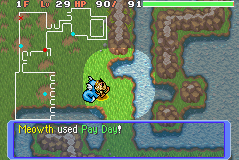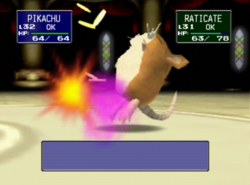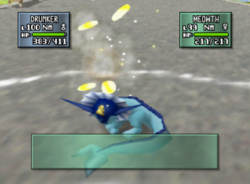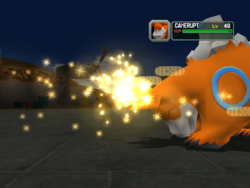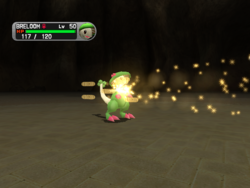Pay Day (move)

|
The picture used in this article is unsatisfactory. Please feel free to replace it so it conforms to Bulbapedia conventions. Reason: Should be replaced with Generation VI images |

|
This move effect may be in need of research. Reason: Does the Ruby/Sapphire glitch occur in Colosseum/XD? You can discuss this on the talk page. |
|---|
| Pay Day ネコにこばん Coin for a Cat | ||||||||||||
| ||||||||||||
Range
| ||||||||||||
Availability
| ||||||||||||
| ||||||||||||
| ||||||||||||
| ||||||||||||
Pay Day (Japanese: ネコにこばん Coin for a Cat) is a damage-dealing Normal-type move introduced in Generation I. It was TM16 in Generation I. It is the signature move of Meowth; prior to Generation IV, it was also the signature move of Persian.
Effect
Generation I
Pay Day does damage and scatters coins on the ground with a value equal to twice the user's level for each time it is used. These coins are picked up afterwards if the player wins the battle.
Generation II
The Amulet Coin doubles the number of coins picked up when held by a Pokémon in battle.
Generation III
Pay Day now scatters coins equal to five times the user's level each time.
Due to a minor glitch in Pokémon Ruby and Sapphire, the wrong amount of money will be displayed if the Amulet Coin is held, leaving the impression that it does not affect Pay Day. Yet, upon checking the Trainer Card, the player will discover that the money earned from Pay Day has been doubled and added to their total savings. This error was fixed in Pokémon FireRed and LeafGreen and all subsequent games.
Generations IV and V
Luck Incense doubles the amount of money picked up (but does not stack with the Amulet Coin).
Generation VI
If the user levels up as a result of the battle, the amount of money is now calculated based on the new level, not the level at which the move was used.
Prize Money Power and Happy Hour increase the amount of money picked up, and can both be stacked with each other and either the Amulet Coin or Luck Incense.
Description
|
Learnset
By leveling up
| # | Pokémon | Type | Level | |||||||||||||
|---|---|---|---|---|---|---|---|---|---|---|---|---|---|---|---|---|
| I | II | III | IV | V | VI | |||||||||||
| 052 | 
|
Meowth | Normal | 17 | 20 | 20 | 18 | 30 | 30 | 30 | ||||||
| 053 | 
|
Persian | Normal | 17 | 20 | 20 | 18 | |||||||||
| Bold indicates a Pokémon gains STAB from this move. Italics indicates a Pokémon whose evolution or alternate form receives STAB from this move. A dash (−) indicates a Pokémon cannot learn the move by the designated method. An empty cell indicates a Pokémon that is unavailable in that game/generation. | ||||||||||||||||
By breeding
| # | Pokémon | Type | Father | |||||||||||
|---|---|---|---|---|---|---|---|---|---|---|---|---|---|---|
| II | III | IV | V | VI | ||||||||||
| 187 | 
|
Hoppip* | Grass | Flying |  
|
|||||||||
| 509 | 
|
Purrloin | Dark | 
|

| |||||||||
| Bold indicates a Pokémon gains STAB from this move. Italics indicates a Pokémon whose evolution or alternate form receives STAB from this move. A dash (−) indicates a Pokémon cannot learn the move by the designated method. An empty cell indicates a Pokémon that is unavailable in that game/generation. | ||||||||||||||
By TM
| # | Pokémon | Type | Machine | |||||||||||||
|---|---|---|---|---|---|---|---|---|---|---|---|---|---|---|---|---|
| I TM16 |
II -- |
III -- |
IV -- |
V -- |
VI -- | |||||||||||
| 025 | 
|
Pikachu | Electric | ✔ | ||||||||||||
| 026 | 
|
Raichu | Electric | ✔ | ||||||||||||
| 031 | 
|
Nidoqueen | Poison | Ground | ✔ | |||||||||||
| 034 | 
|
Nidoking | Poison | Ground | ✔ | |||||||||||
| 052 | 
|
Meowth | Normal | ✔ | ||||||||||||
| 053 | 
|
Persian | Normal | ✔ | ||||||||||||
| 054 | 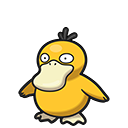
|
Psyduck | Water | ✔ | ||||||||||||
| 055 | 
|
Golduck | Water | ✔ | ||||||||||||
| 056 | 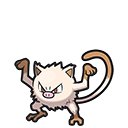
|
Mankey | Fighting | ✔ | ||||||||||||
| 057 | 
|
Primeape | Fighting | ✔ | ||||||||||||
| 079 | 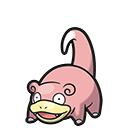
|
Slowpoke | Water | Psychic | ✔ | |||||||||||
| 080 | 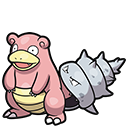
|
Slowbro | Water | Psychic | ✔ | |||||||||||
| 086 | 
|
Seel | Water | ✔ | ||||||||||||
| 087 | 
|
Dewgong | Water | Ice | ✔ | |||||||||||
| 112 | 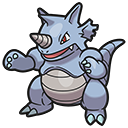
|
Rhydon | Ground | Rock | ✔ | |||||||||||
| 143 | 
|
Snorlax | Normal | ✔ | ||||||||||||
| 150 | 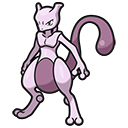
|
Mewtwo | Psychic | ✔ | ||||||||||||
| 151 | 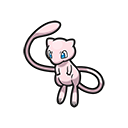
|
Mew | Psychic | ✔ | ||||||||||||
| Bold indicates a Pokémon gains STAB from this move. Italics indicates a Pokémon whose evolution or alternate form receives STAB from this move. A dash (−) indicates a Pokémon cannot learn the move by the designated method. An empty cell indicates a Pokémon that is unavailable in that game/generation. | ||||||||||||||||
Special move
Generation III
| ||||||||||||||||||
By event
Generation I
| ||||||||||||||||||||||||
Generation II
| ||||||||||||||||||
In other games
Pokémon Mystery Dungeon series
In Pokémon Mystery Dungeon: Red Rescue Team and Blue Rescue Team, the move inflicts damage and forces the target to drop Poké.
Super Smash Bros. series
When a Meowth appears from a Poké Ball in Super Smash Bros., Super Smash Bros. Brawl, and Super Smash Bros. for Nintendo 3DS/Wii U, it uses Pay Day to hurl coins at opponents.
Description
|
In the anime
| Numerous coins are hurled at the foe to inflict damage. | |||
| Pokémon | Method | ||
|---|---|---|---|
| User | First Used In | Notes | |

|
Meowth crosses its arms, then opens them quickly and multiple glowing white balls come out of the charm on its head. | ||
| The Black Arachnid's Meowth | Spinarak Attack | Debut | |
In the anime, Team Rocket's Meowth has stated he is unable to learn Pay Day. He is quoted as claiming it is because learning how to walk and talk like a human used up all his move slots.
In the manga
In the Pokémon Adventures manga
| Numerous coins are hurled at the foe to inflict damage. | |||
| Pokémon | Method | ||
|---|---|---|---|
| User | First Chapter Used In | Notes | |

|
Fearow flaps its wings and multiple gold coins that look like a Meowth's charm comes out of them and fly at the opponent. | ||
| Pokémon Fan Club Chairman's Fearow | The Coming of Slowpoke (Eventually) | Debut Japanese event-exclusive move | |

|
Rapidash points its head towards the opponent and multiple gold coins that look like a Meowth's charm appear and hit the opponent. | ||
| Pokémon Fan Club Chairman's Rapidash | The Coming of Slowpoke (Eventually) | Debut Japanese event-exclusive move | |

|
Meowth points one of its paws at the opponent and multiple gold coins that look like its charm appear and shoot at the opponent. | ||
| Unknown Trainer's Meowth | The Coming of Slowpoke (Eventually) | None | |
In the Pokémon Gotta Catch 'Em All manga
| Numerous coins fall out if the foe is hit. | |||
| Pokémon | Method | ||
|---|---|---|---|
| User | First Chapter Used In | Notes | |

|
Meowth smacks the opponent and forces coins to fall out. | ||
| Masatoshi's Meowth | Gag Battles | Debut | |
In other generations
Trivia
- In Generation I, Pay Day was one of only three methods (discounting glitches) to earn money once all Trainers were defeated, the other two being selling items (obtaining them with Coins after all other items are sold) and battling the Elite Four and Champion.
- The Japanese name of the move is an idiom equivalent to "to cast pearls before swine." The coins depicted in the move's animation are koban, gold coins used in the Edo period of feudal Japan, the same type of coin as the one on Meowth's head.
In other languages
| |||||||||||||||||||||||||||||||||||||||||||||||||||
| Generation I TMs | |
|---|---|
| 01 • 02 • 03 • 04 • 05 • 06 • 07 • 08 • 09 • 10 • 11 • 12 • 13 • 14 • 15 • 16 • 17 • 18 • 19 • 20 • 21 • 22 • 23 • 24 • 25 26 • 27 • 28 • 29 • 30 • 31 • 32 • 33 • 34 • 35 • 36 • 37 • 38 • 39 • 40 • 41 • 42 • 43 • 44 • 45 • 46 • 47 • 48 • 49 • 50 | |
| Generation I HMs | |
| 01 • 02 • 03 • 04 • 05 | |

|
This article is part of Project Moves and Abilities, a Bulbapedia project that aims to write comprehensive articles on two related aspects of the Pokémon games. |











